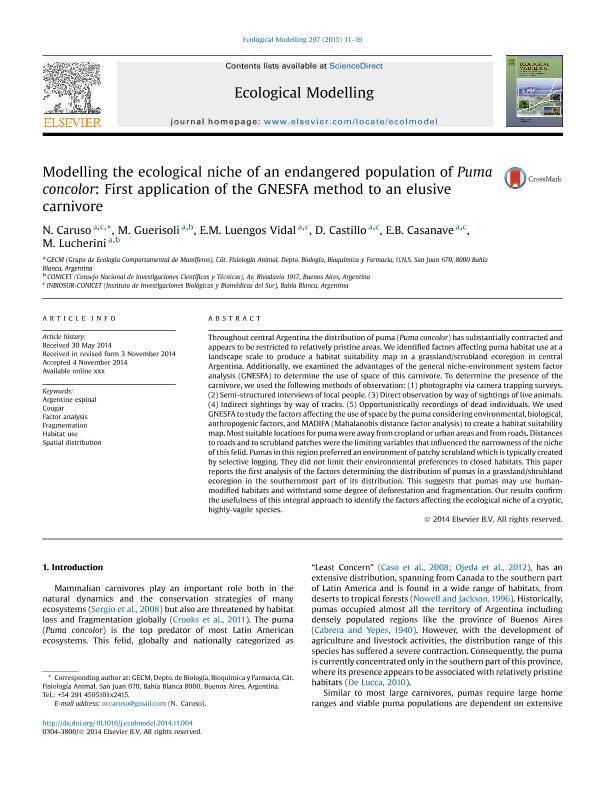Artículo
Modelling the ecological niche of an endangered population of Puma concolor: First application of the GNESFA method to an elusive carnivore
Caruso, Nicolás ; Guerisoli, Maria de Las Mercedes
; Guerisoli, Maria de Las Mercedes ; Luengos Vidal, Estela Maris
; Luengos Vidal, Estela Maris ; Castillo, Diego Fabian
; Castillo, Diego Fabian ; Casanave, Emma Beatriz
; Casanave, Emma Beatriz ; Lucherini, Mauro
; Lucherini, Mauro
 ; Guerisoli, Maria de Las Mercedes
; Guerisoli, Maria de Las Mercedes ; Luengos Vidal, Estela Maris
; Luengos Vidal, Estela Maris ; Castillo, Diego Fabian
; Castillo, Diego Fabian ; Casanave, Emma Beatriz
; Casanave, Emma Beatriz ; Lucherini, Mauro
; Lucherini, Mauro
Fecha de publicación:
02/2015
Editorial:
Elsevier
Revista:
Ecological Modelling
ISSN:
0304-3800
Idioma:
Inglés
Tipo de recurso:
Artículo publicado
Clasificación temática:
Resumen
Throughout central Argentina the distribution of puma (Puma concolor) has substantially contracted and appears to be restricted to relatively pristine areas. We identified factors affecting puma habitat use at a landscape scale to produce a habitat suitability map in a grassland/scrubland ecoregion in central Argentina. Additionally, we examined the advantages of the general niche-environment system factor analysis (GNESFA) to determine the use of space of this carnivore. To determine the presence of the carnivore, we used the following methods of observation: (1) photographs via camera trapping surveys. (2) Semi-structured interviews of local people. (3) Direct observation by way of sightings of live animals. (4) Indirect sightings by way of tracks. (5) Opportunistically recordings of dead individuals. We used GNESFA to study the factors affecting the use of space by the puma considering environmental, biological, anthropogenic factors, and MADIFA (Mahalanobis distance factor analysis) to create a habitat suitability map. Most suitable locations for puma were away from cropland or urban areas and from roads. Distances to roads and to scrubland patches were the limiting variables that influenced the narrowness of the niche of this felid. Pumas in this region preferred an environment of patchy scrubland which is typically created by selective logging. They did not limit their environmental preferences to closed habitats. This paper reports the first analysis of the factors determining the distribution of pumas in a grassland/shrubland ecoregion in the southernmost part of its distribution. This suggests that pumas may use human-modified habitats and withstand some degree of deforestation and fragmentation. Our results confirm the usefulness of this integral approach to identify the factors affecting the ecological niche of a cryptic, highly-vagile species.
Archivos asociados
Licencia
Identificadores
Colecciones
Articulos(CCT - BAHIA BLANCA)
Articulos de CTRO.CIENTIFICO TECNOL.CONICET - BAHIA BLANCA
Articulos de CTRO.CIENTIFICO TECNOL.CONICET - BAHIA BLANCA
Articulos(INBIOSUR)
Articulos de INSTITUTO DE CIENCIAS BIOLOGICAS Y BIOMEDICAS DEL SUR
Articulos de INSTITUTO DE CIENCIAS BIOLOGICAS Y BIOMEDICAS DEL SUR
Citación
Caruso, Nicolás; Guerisoli, Maria de Las Mercedes; Luengos Vidal, Estela Maris; Castillo, Diego Fabian; Casanave, Emma Beatriz; et al.; Modelling the ecological niche of an endangered population of Puma concolor: First application of the GNESFA method to an elusive carnivore; Elsevier; Ecological Modelling; 297; 2-2015; 11-19
Compartir
Altmétricas



